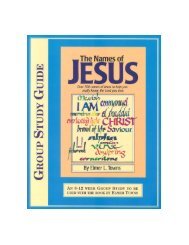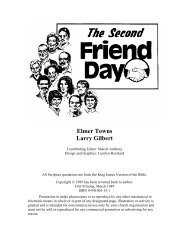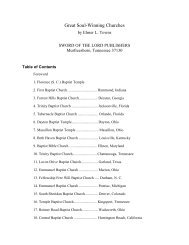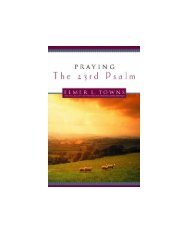PUTTING AN END TO WORSHIP WARS - Elmer Towns
PUTTING AN END TO WORSHIP WARS - Elmer Towns
PUTTING AN END TO WORSHIP WARS - Elmer Towns
- TAGS
- worship
- elmer
- towns
- elmertowns.com
You also want an ePaper? Increase the reach of your titles
YUMPU automatically turns print PDFs into web optimized ePapers that Google loves.
once. Ward Presbyterian Church, Livonia, Michigan, has four worship services on Sunday<br />
morning. Grace Baptist Church located in Simi Valley, 40 miles north of Los Angeles,<br />
California, has six worship services a week in its auditorium that seats 225 worshippers<br />
(Wednesday night, Friday night, Saturday night, two Sunday AM services and Monday night).<br />
Some use the multi-services to conduct different types of worship services. Stephen<br />
Hower, St. John's Lutheran Church, West County, St. Louis, Missouri, had the traditional<br />
Lutheran liturgical services, plus a seeker sensitive service. Realizing that different expressions<br />
of worship attract people of different cultures, age, or class background, the multi-service<br />
worship programs will influence worship in the church. It will (a) make the church more tolerant<br />
because we reach people according to their background, and (b) segregate the church into<br />
divisions, because we keep people with their own rather than putting them with people of<br />
different backgrounds to enrich them.<br />
3. Multi-cultural. As more and more cultural groups immigrate to the United states,<br />
their presence demands the church to reach and evangelize them. Many churches, specifically<br />
urban churches, are having a church service in a different language or if in English; targeting<br />
different ethnic-linguistic minorities. These are specific worship services for Hispanics,<br />
Koreans, Chinese, Japanese, Laotians, Cambodians, etc. According to C. Peter Wagner,<br />
professor at Fuller Theological Seminary, the number of Korean language churches in the United<br />
States has grown from 200 in 1980 to approximately 4,000 by 1995. The number of Korean<br />
language theological seminaries in the United States has jumped from 0 to approximately 50<br />
during the same time.<br />
The presence of minorities in America that represent a different culture and different<br />
language, will force the traditional American churches: (1) to reach out to them, (2) to<br />
incorporate them, (3) to involve them in ministry to their own, (4) to adapt to their culture, and<br />
(5) to let them change us or we change them. The presence of minorities will change the<br />
expression of worship, even the face of worship. Their musical instruments, their dress and the<br />
way they phrase their ideas will influence our worship. Their food, the way they related to one<br />
another and their customs will influence the way we fellowship with them and incorporate them<br />
into the local body of Christ.<br />
4. Multi-media. America has moved from a print society to an electronic society.<br />
Worshippers have evolved from getting most of the data by reading to getting most of their<br />
information from television, the computer and the Internet. The way young people learn about<br />
the world and God will influence the way they worship God. Since they are used to learning by<br />
experiencing, seeing, touching, feeling, and doing; we no longer can reach them with lineal<br />
educational experiences, i.e. reading and talking; which are the traditional methods of worship.<br />
Since they learn by multiple methods, the church is turning to multi-media in worship.<br />
They learn by watching activities, events and daily life on television. The church is using drama,<br />
skits, characterization and shorts plays in worship services. Since they are influenced by music<br />
during the week, the church is using contemporary music to attract, teach, involve, entertain.
















